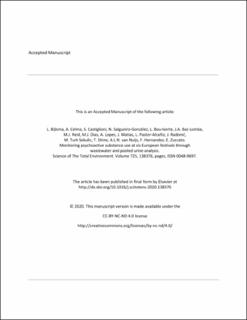| dc.contributor.author | Bijlsma, Lubertus | |
| dc.contributor.author | Celma, Alberto | |
| dc.contributor.author | Castiglioni, Sara | |
| dc.contributor.author | Salgueiro-González, Noelia | |
| dc.contributor.author | Bou-Iserte, Lledó | |
| dc.contributor.author | Baz Lomba, Jose Antonio | |
| dc.contributor.author | Reid, Malcolm James | |
| dc.contributor.author | Dias, Mário João Rodrigues | |
| dc.contributor.author | Lopes, Alvaro | |
| dc.contributor.author | Matias, João | |
| dc.contributor.author | Pastor-Alcañiz, Laura | |
| dc.contributor.author | Radonić, Jelena L. | |
| dc.contributor.author | Turk Sekulic, Sekulic | |
| dc.contributor.author | Shine, Trevor | |
| dc.contributor.author | van Nuijs, Alexander L.N. | |
| dc.contributor.author | Hernández, Félix | |
| dc.contributor.author | Zuccato, Ettore | |
| dc.date.accessioned | 2020-09-23T13:39:16Z | |
| dc.date.available | 2020-09-23T13:39:16Z | |
| dc.date.created | 2020-09-06T14:07:42Z | |
| dc.date.issued | 2020 | |
| dc.identifier.citation | Science of the Total Environment. 2020, 725, 138376. | en_US |
| dc.identifier.issn | 0048-9697 | |
| dc.identifier.uri | https://hdl.handle.net/11250/2679335 | |
| dc.description | Embargo until 03.04.2022 | en_US |
| dc.description.abstract | The consumption of psychoactive substances is considered a growing problem in many communities. Moreover, new psychoactive substances (NPS) designed as (legal) substitutes to traditional illicit drugs are relatively easily available to the public through e-commerce and retail shops, but there is little knowledge regarding the extent and actual use of these substances. This study aims to gain new and complementary information on NPS and traditional illicit drug use at six music festivals across Europe by investigating wastewater and pooled urine. Samples were collected, between 2015 and 2018, at six music festivals across Europe with approximately 465.000 attendees. Wastewater samples were also collected during a period not coinciding with festivals. A wide-scope screening for 197 NPS, six illicit drugs and known metabolites was applied using different chromatography-mass spectrometric strategies. Several illicit drugs and in total 21 different NPS, mainly synthetic cathinones, phenethylamines and tryptamines, were identified in the samples. Ketamine and the traditional illicit drugs, such as amphetamine-type stimulants, cannabis and cocaine were most abundant and/or frequently detected in the samples collected, suggesting a higher use compared to NPS. The analyses of urine and wastewater is quick and a high number of attendees may be monitored anonymously by analysing only a few samples which allows identifying the local profiles of use of different drugs within a wide panel of psychoactive substances. This approach contributes to the development of an efficient surveillance system which can provide timely insight in the trends of NPS and illicit drugs use. | en_US |
| dc.language.iso | eng | en_US |
| dc.publisher | Elsevier | en_US |
| dc.rights | Attribution-NonCommercial-NoDerivatives 4.0 Internasjonal | * |
| dc.rights.uri | http://creativecommons.org/licenses/by-nc-nd/4.0/deed.no | * |
| dc.title | Monitoring psychoactive substance use at six European festivals through wastewater and pooled urine analysis | en_US |
| dc.type | Peer reviewed | en_US |
| dc.type | Journal article | en_US |
| dc.description.version | acceptedVersion | en_US |
| dc.source.pagenumber | 10 | en_US |
| dc.source.volume | 725 | en_US |
| dc.source.journal | Science of the Total Environment | en_US |
| dc.identifier.doi | 10.1016/j.scitotenv.2020.138376 | |
| dc.identifier.cristin | 1827563 | |
| cristin.ispublished | true | |
| cristin.fulltext | postprint | |
| cristin.qualitycode | 2 | |

